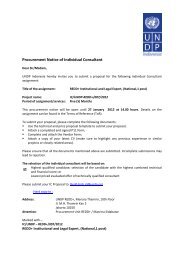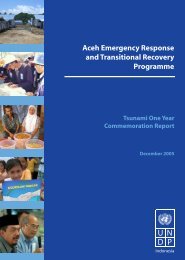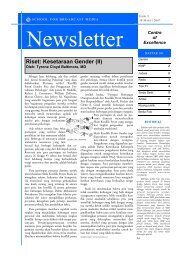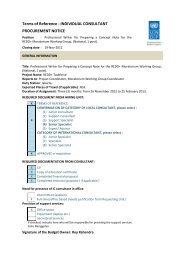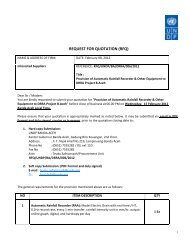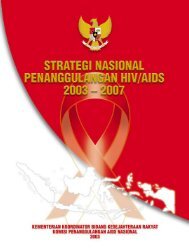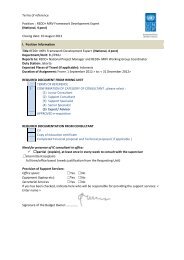nets that could automatically be activated in an economicdownturn – an additional argument for having suchprogrammes in <strong>the</strong> future.It should be emphasized, however, that simplyincreasing social spending will not in itself improve socialservices. In <strong>the</strong> past public spending has often been oflow quality, compromised by widespread corruption andrent-seeking – though this inefficiency and <strong>the</strong> consequentdrain on public resources was masked by economicgrowth and by oil revenues that sustained public finances.In <strong>the</strong> current, more constrained environment <strong>the</strong>government will have to pay much more attention towastage and cost effectiveness.It will also have to tackle corruption. Evidence fromcross-country comparisons suggests that corruption notonly reduces efficiency it also alters <strong>the</strong> composition ofgovernment spending – tending to reduced education andhealth investment, presumably because compared witho<strong>the</strong>r areas <strong>the</strong>se expenditures offer fewer opportunitiesfor rent-seeking. 71 Fortunately in a more open anddemocratic environment fiscal policymaking can besubjected to greater scrutiny and <strong>the</strong> rigours of democraticdebate and can also be tailored to <strong>the</strong> new realities ofdecentralization.Social spending under fiscal decentralizationFollowing decentralization from 2001, <strong>Indonesia</strong> hasnow experienced nearly three years of regional autonomythat has shifted much of <strong>the</strong> responsibility for publicservices to <strong>the</strong> local level. And whereas in <strong>the</strong> past flowsof funds from <strong>the</strong> centre to <strong>the</strong> regions generally took <strong>the</strong>form of earmarked grants <strong>the</strong> new fiscal framework relieslargely on a general grant. Along side fiscal decentralization,<strong>the</strong> country has switched to a new accountability systemat <strong>the</strong> local level, with <strong>the</strong> head of <strong>the</strong> region being electedby regional parliaments, which in turn are elected bypopular vote.This new system entails certain risks but <strong>the</strong>se shouldbe outweighed by <strong>the</strong> benefits. In place of <strong>the</strong> earlier topdowntechnocratic approach to resource allocation, <strong>the</strong>new system allows available resources to be bettermatched to local needs. Chapter two of this report hasdemonstrated that regions differ not just in <strong>the</strong>ir overalllevels of human development but also in <strong>the</strong>ir patterns ofdeficiency in <strong>the</strong> different dimensions of humandevelopment. Each region will thus have its own priorities.In education, for example, some regions have an excellentrecord in primary enrolment, but have done ra<strong>the</strong>r poorlyin junior secondary enrolment. 72The new system fosters a rights-based approach tohuman development since it should allow local people toparticipate in decision making on resource allocation andprogramme implementation. This is not just a democraticimperative, it also has economic benefits. The differentareas of human development and poverty alleviation havesynergistic relationships –interventions in one can reinforce<strong>the</strong> impact of ano<strong>the</strong>r (Box 3.3, p. 28). For example, if<strong>the</strong> aim is to increase school enrolment, investment inbuilding more schools will be much more effective if it isaccompanied by efforts to reduce <strong>the</strong> extreme povertythat often keeps children away from school. However, itis difficult for planners to devise a combination ofinterventions based simply on economic criteria. Localpeople, with superior information about <strong>the</strong> complexitiesof local needs are in a better position to achieve this balance.Local governments can also be more flexible andresponsive when it comes to budgeting. When drawingup budgets, central planners tend to replicate previouspatterns of expenditure, making incremental adjustments.At <strong>the</strong> local level, on <strong>the</strong> o<strong>the</strong>r hand, <strong>the</strong>re should be muchgreater scope for a fresh approach – starting again fromscratch with what is called ‘zero-based’ budgeting (seeBox 5.1). When <strong>the</strong> aim is to make a distinct break with<strong>the</strong> past this approach helps reorient public spending muchmore towards human development.Decentralization does, of course, also entail risks. Thereis no guarantee that opportunities for local level flexibilitywill be used in a positive way. While some regions arealready forging ahead with innovations in service delivery,o<strong>the</strong>rs have allocated only meagre amounts to health andeducation. One way to address this is by establishingminimum service delivery standards. However, <strong>the</strong>sestandards will need to be supported financially – throughequalizing grants from <strong>the</strong> central government to <strong>the</strong>poorest districts.Ano<strong>the</strong>r danger of decentralization is that corruptionand rent-seeking at <strong>the</strong> centre will be replicated, in aneven worse form, at <strong>the</strong> local level – again not only wastingresources but also jeopardizing <strong>the</strong> prospect of betterresource allocations. Corrupt local governments may, forexample, show a bias towards large construction projectson which it is easier to collect substantial bribes, ra<strong>the</strong>rthan towards routine expenditure such as textbook supplyor teachers’ salaries. The spending priorities can thuseasily get distorted.Decentralization also requires stronger local institutions.People’s needs can be reflected in resource allocationsonly if <strong>the</strong>re are institutional mechanisms that canarticulate such needs. Local people will need to worktoge<strong>the</strong>r in community-based organizations through which<strong>the</strong>y, and not just local elites, can have a say overallocations. They can also better identify impact ofmisgovernance and corruption – whe<strong>the</strong>r in <strong>the</strong> poor qualityof schooling or health care or in <strong>the</strong> weak implementationof local development projects. They are <strong>the</strong>refore in abetter position to make well informed criticisms anddemand better governance.71 See Mauro (2002).72 For example, Bangkalan district in East Java has a high primary enrolment ratio of 98%, but its junior school enrolment rate is only about 40%, compared to <strong>the</strong> district averageof about 70%. The situation is similar in Pandeglang in West Java.54National <strong>Human</strong> <strong>Development</strong> <strong>Report</strong> 2004
Ano<strong>the</strong>r risk from decentralization is that it couldexacerbate regional disparities. <strong>Indonesia</strong> already has sharpcontrasts between districts: in 2001, on a per capita basis<strong>the</strong> richest local government had 50 times more revenuethan <strong>the</strong> poorest one. 73 These gaps seem likely to widen.This is first because districts are now allowed to keep ashare of <strong>the</strong> benefits from oil and o<strong>the</strong>r natural resourcesthat are on <strong>the</strong>ir territories. Second <strong>the</strong> richer districtshave a stronger tax base so should be able to gain morerevenue from local taxes. As a result, while <strong>the</strong> richerregions should have more resources to invest in humandevelopment <strong>the</strong> poorer regions will be hard-pressed toattain minimum service standards, let alone improve upon<strong>the</strong>m. As <strong>the</strong> regions get more taxing authority, this willneed to be offset by equalizing arrangements for revenuesharing.Never<strong>the</strong>less, it seems inevitable that regional disparitieswill remain for <strong>the</strong> foreseeable future and that someregions will prosper more than o<strong>the</strong>rs. In <strong>the</strong>secircumstances <strong>Indonesia</strong> needs to arrive at a nationalconsensus on meeting citizens’ human development rightsand should establish a minimum socially acceptableuniversal level of human development and allocate itsresources accordingly.This does not necessarily mean aiming for equality ofincome but ra<strong>the</strong>r for equity in <strong>the</strong> development of humancapabilities. This not only fulfils people’s basic rights, italso brings economic benefits since public investment inhuman development is likely to bring higher returns inrelatively backward regions than in <strong>the</strong> advanced regions.For example, new schools are likely to attract more newstudents in areas where enrolment is relatively low. 74 Thismay also be true of many small-scale investment projects,such as those for irrigation, where investment can creategreater income-earning opportunities for <strong>the</strong> poor than if<strong>the</strong>y were invested in large-scale manufacturing or serviceindustries.A social sector fund – a means to protect socialspendingHow can <strong>the</strong> government ensure that social spendingis raised and maintained given tight budgetary constraintsand <strong>the</strong> implications of decentralization? One way todemonstrate <strong>the</strong> government’s commitment is to earmarkfunds for designated social spending by creating a SocialSector Fund (SSF). 75There are a number of ways a SSF can be created.For example, it could be built up by taking a certainpercentage of proceeds from <strong>the</strong> exploitation of naturalresources. Since <strong>the</strong>se resources are ultimately ownedby all <strong>Indonesia</strong>ns one of <strong>the</strong> best ways to ensure that <strong>the</strong>benefits are shared equitably is through social spending.Regions with richer resource endowments would thusmake a larger contribution.As <strong>the</strong> <strong>Indonesia</strong>n economy becomes more marketcentred, fewer public funds will be needed to subsidizestate-owned enterprises, leaving resources that can beredirected to <strong>the</strong> social sector. Moreover, following <strong>the</strong>example of <strong>the</strong> fuel subsidy compensation fund, 76 <strong>the</strong> SSFcould also be allocated a percentage of <strong>the</strong> proceeds fromprivatization and from any savings from reforms andrestructuring. India, for example, uses this system and in2001-02 allocated <strong>the</strong> equivalent of Rp. 1 billion fromprivatization proceeds to <strong>the</strong> social sectors. 77 This systemhas <strong>the</strong> added advantage of creating greater support forreforms. 78Ano<strong>the</strong>r possibility is to apply a social sector levy oncorporations. This can be justified to corporations on <strong>the</strong>grounds that it can help moderate wage claims: workerswho as a result of greater social spending benefit fromsubsidised or free education, health care and o<strong>the</strong>r socialservices should have less need to press for higher wages.A social fund levy would not <strong>the</strong>refore necessarily add tobusiness costs. Businesses also gain since <strong>the</strong>y can takeadvantage of a better educated and better nourished labourforce that will be more productive. 79 A similar levy can beapplied to wealthy individuals. This could also be linkedto Zakat – an obligatory charity for well-to-do Muslims –allowing <strong>the</strong> SSF levy to be offset against Zakat. Thesemandatory funding sources of SSF can also besupplemented by voluntary contributions through taxdeductible charities and donations.However, this kind of system can only work ifcontributors to <strong>the</strong> fund, whe<strong>the</strong>r compulsory orvoluntary, have confidence in its management. Peoplegenerally comply with such revenue collecting measureswhen <strong>the</strong>y see <strong>the</strong>ir money is spent on worthy causes.73 See World Bank (2003a), p.iv.74 To some extent, this may be counterbalanced by <strong>the</strong> higher costs of providing services in remote areas.75 One may argue that such earmarked funds are fungible. That is, overall spending does not necessarily increase in <strong>the</strong> earmarked sector, as <strong>the</strong> government shifts its non-earmarkedspending to o<strong>the</strong>r sectors. However, <strong>the</strong>re is very little evidence for this. Most empirical studies find that when funds are earmarked, spending does increase, although it maynot rise by <strong>the</strong> expected amount.76 In <strong>the</strong> 1999/2000 budget fuel subsidies amounted to Rp. 40.9 trillion. In <strong>the</strong> 2001 budget, Rp. 2.2 trillion were allocated to a social compensation fund for education, health,food, transportation, clean water etc. In <strong>the</strong> 2002 budget <strong>the</strong> allocation was Rp. 2.85 trillion, including Rp. 570 billion for <strong>the</strong> health sector to cover free in-patient care for <strong>the</strong>poor in 446 public hospitals, free generic drugs for 47.9 million poor and free hepatitis vaccines for 1.5 million poor people. In 2003, Rp. 4.43 trillion were budgeted tocompensate 30 million people for <strong>the</strong> effects of <strong>the</strong> 22% increase in fuel prices.77 Prabhu (2003).78 The Australian government successfully generated support for <strong>the</strong> sale of publicly owned telecommunication corporation, Telstra, by creating a special fund from <strong>the</strong> salesproceeds to be used for <strong>the</strong> environmental cause.79 Singapore successfully used a levy on corporations to create a Skill <strong>Development</strong> Fund (SDF) for financing <strong>the</strong> training of unskilled workers. This eventually raisedproductivity and hence reduced unit labour costs which helped corporations to enhance and maintain <strong>the</strong>ir international competitiveness. Ano<strong>the</strong>r example of a successfulearmarked levy is <strong>the</strong> Employment Guarantee Scheme in <strong>the</strong> state of Maharashtra in India which is funded through resources raised mainly from urban areas to provideemployment for unskilled labour in rural areas.National <strong>Human</strong> <strong>Development</strong> <strong>Report</strong> 2004 55
- Page 2 and 3:
NationalHuman DevelopmentReport 200
- Page 4 and 5:
ForewordIndonesia has made critical
- Page 6 and 7:
AcknowledgementsThis Report is a re
- Page 8:
AbbreviationsAPBDAPBNASEANBAPPENASB
- Page 11 and 12:
TABLES2.1 - Comparison of per capit
- Page 13 and 14:
EXECUTIVE SUMMARYIndonesiaNational
- Page 15 and 16: to meet the Millennium Development
- Page 17 and 18: Chapter 1Indonesia in transition:To
- Page 19 and 20: The place of human development in I
- Page 21 and 22: Chapter 2The state of human develop
- Page 23 and 24: Figure 2.4 - Map of human developme
- Page 25 and 26: Figure 2.4 - Social indicators, 197
- Page 27 and 28: of income and corporate taxes has r
- Page 29 and 30: Figure 2.10 - GDP growth, 1990-2003
- Page 31 and 32: Table 2.4 - Proportion of total bri
- Page 33 and 34: In addition, the overall sense of p
- Page 35 and 36: themselves. On this basis Indonesia
- Page 37 and 38: Box 3.2 - Pathways to human develop
- Page 39 and 40: Table 3.3 - Infant mortality rate a
- Page 41 and 42: poor is a clear recognition that de
- Page 43 and 44: educing the infant mortality rate m
- Page 45 and 46: assuming that 1.3 trillion would co
- Page 47 and 48: The national figure would certainly
- Page 49 and 50: expenditure. In practice, it would
- Page 51 and 52: Table 4.2 - Provincial breakdown of
- Page 53 and 54: administration, plus an allowance f
- Page 55 and 56: Figure 4.5 - Ratio of salaries of p
- Page 57 and 58: Appendix to Chapter 4Health and edu
- Page 59 and 60: The third is the ‘Special Fund’
- Page 61 and 62: Chapter 5Rethinking fiscal prioriti
- Page 63 and 64: At the very outset, however, it sho
- Page 65: enforcement particularly for person
- Page 69 and 70: Box 5.2 - Variations in poverty con
- Page 71 and 72: physical security - which contribut
- Page 73 and 74: centre, for example, played a signi
- Page 75 and 76: BibliographyAbidin, A. (2002), 1 st
- Page 77 and 78: LPEM-FEUI (2004), Draft Final Repor
- Page 79 and 80: Subbarao, K., A. Bonnerjee, J. Brai
- Page 81 and 82: HUMAN DEVELOPMENT INDICATORS AND IN
- Page 83 and 84: The human development approach brin
- Page 85 and 86: Box 2HDI, HPI-1, GDI and GEMHuman D
- Page 87 and 88: What do the human developmentindice
- Page 89 and 90: Table 1 - Districts making the grea
- Page 91 and 92: Table 2 - Districts with the highes
- Page 93 and 94: Figure 8 - GDI by province, 1999-20
- Page 95 and 96: Figure 12 - HPI by components, 1999
- Page 97 and 98: Technical workshopon human developm
- Page 99 and 100: • The percentage of households wi
- Page 101 and 102: 11 Percentage of people with self-t
- Page 103 and 104: Annex 2N a m esGROUP IIChairperson:
- Page 105 and 106: Changes in names due to the formati
- Page 107 and 108: LampungKab. Lampung Selatan (South
- Page 109 and 110: 1Human Development Index (HDI)by pr
- Page 111 and 112: 3Gender-related Development Index (
- Page 113 and 114: 5Human Poverty Index (HPI)by provin
- Page 115 and 116: ProvinceDistrictLiveexpectancy(year
- Page 117 and 118:
ProvinceDistrictLiveexpectancy(year
- Page 119 and 120:
ProvinceDistrictLiveexpectancy(year
- Page 121 and 122:
ProvinceDistrictLiveexpectancy(year
- Page 123 and 124:
ProvinceDistrictLife expectancy(yea
- Page 125 and 126:
ProvinceDistrictLife expectancy(yea
- Page 127 and 128:
ProvinceDistrictLife expectancy(yea
- Page 129 and 130:
8Gender Development Index (GDI)by d
- Page 131 and 132:
ProvinceDistrictProportionof popula
- Page 133 and 134:
ProvinceDistrictProportionof popula
- Page 135 and 136:
ProvinceDistrictProportionof popula
- Page 137 and 138:
9Gender Empowerment Measure (GEM)by
- Page 139 and 140:
ProvinceDistrictParticipationof wom
- Page 141 and 142:
ProvinceKabupaten/KotaDistrictParti
- Page 143 and 144:
ProvinceKabupaten/KotaDistrictParti
- Page 145 and 146:
ProvinceDistrictParticipationof wom
- Page 147 and 148:
ProvinceDistrictParticipationof wom
- Page 149 and 150:
ProvinceDistrictParticipationof wom
- Page 151 and 152:
ProvinceDistrictParticipationof wom
- Page 153 and 154:
ProvinceDistrictPeople notexpected
- Page 155 and 156:
ProvinceDistrictPeople notexpected
- Page 157 and 158:
ProvinceDistrictPeople notexpected
- Page 159 and 160:
ProvinceDistrictPeople notexpected
- Page 161 and 162:
ProvinceDistrictInfantmortalityrate
- Page 163 and 164:
ProvinceDistrictInfantmortalityrate
- Page 165 and 166:
ProvinceDistrictInfantmortalityrate
- Page 167 and 168:
ProvinceDistrictInfantmortalityrate
- Page 169 and 170:
ProvinceDistrictSchool Participatio
- Page 171 and 172:
ProvinceDistrictSchool Participatio
- Page 173 and 174:
ProvinceDistrictSchool Participatio
- Page 175 and 176:
ProvinceDistrictSchool Participatio
- Page 177 and 178:
ProvinceDistrictHouseholds withacce
- Page 179 and 180:
ProvinceDistrictHouseholds withacce
- Page 181 and 182:
ProvinceDistrictHouseholds withacce
- Page 183 and 184:
ProvinceDistrictHouseholds withacce
- Page 185 and 186:
ProvinceDistrictReal per capita GRD
- Page 187 and 188:
ProvinceDistrictReal per capita GRD
- Page 189 and 190:
ProvinceDistrictReal per capita GRD
- Page 191 and 192:
ProvinceDistrictReal per capita GRD
- Page 193 and 194:
ProvinceDistrictLabourforceparticip
- Page 195 and 196:
ProvinceDistrictLabourforceparticip
- Page 197 and 198:
ProvinceDistrictLabourforceparticip
- Page 199 and 200:
ProvinceDistrictLabourforceparticip
- Page 201 and 202:
ProvinceDistrictDevelopmentexpendit
- Page 203 and 204:
ProvinceDistrictDevelopmentexpendit
- Page 205 and 206:
ProvinceDistrictDevelopmentexpendit
- Page 207 and 208:
ProvinceDistrictDevelopmentexpendit
- Page 209 and 210:
Computing the indicesThe Human Deve
- Page 211 and 212:
Calculating the HDIThis illustratio
- Page 213 and 214:
Calculating the GDIAs an example, t
- Page 215 and 216:
Definitions of Statistical TermsAcc
- Page 217:
School drop-out rate: the proportio




